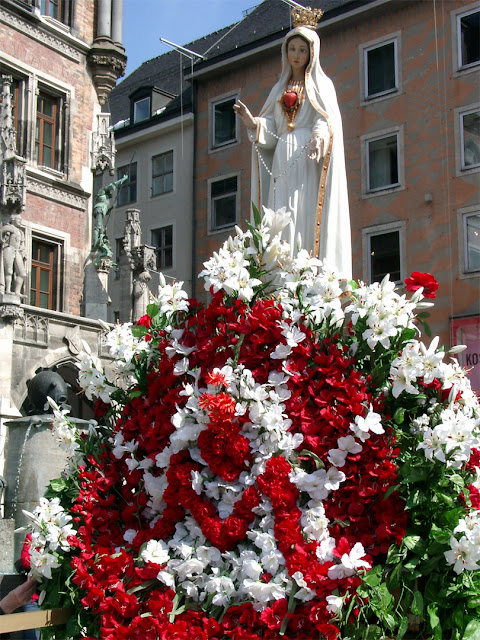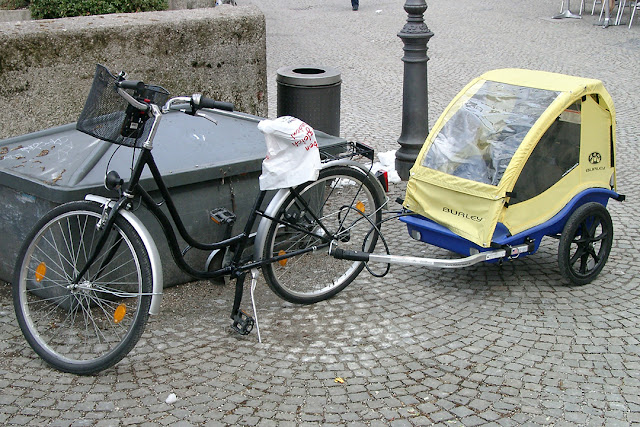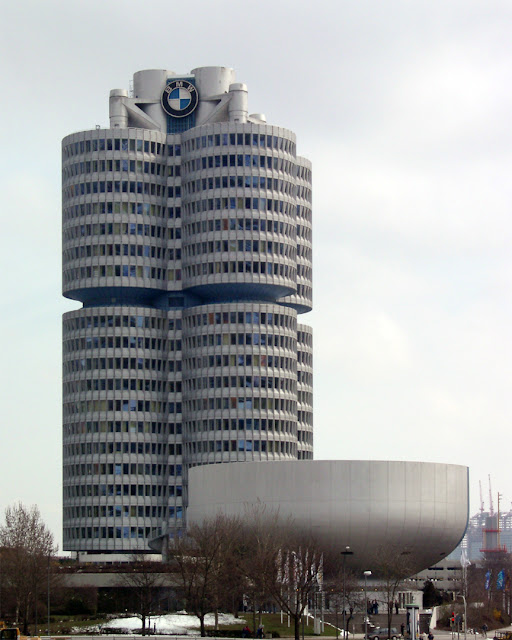Tuesday, September 30, 2008
Wendeltreppe
Wendeltreppe (Spiral staircase)
Heilig-Geist-Kirche
Prälat-Miller-Weg
Munich, March 2004
“Heilig-Geist-Kirche (Church of the Holy Spirit; lit. Holy Ghost Church) is a Gothic hall church in Munich, southern Germany, originally belonging to the Hospice of the Holy Ghost (14th century). It was remodelled in 1724–30 by Johann Georg Ettenhofer (vaults, renovation of pillars); in the interior are Rococo frescoes and stucco ornament by the Asam brothers. After the demolition of the hospice buildings in 1885, Franz Lšwel added three bays at the west end of the church and gave it a Neo-Baroque facade. The church suffered severe damage during World War II and its interior furnishings were largely destroyed; extensive rebuilding and restoration was carried out after the war. The interior of the church was renovated in 1991.” (Heilig-Geist-Kirche, Wikipedia)
Monday, September 29, 2008
Heilig-Geist-Kirche
Heilig-Geist-Kirche
Prälat-Miller-Weg
Munich, March 2004
“Heilig-Geist-Kirche (Church of the Holy Spirit; lit. Holy Ghost Church) is a Gothic hall church in Munich, southern Germany, originally belonging to the Hospice of the Holy Ghost (14th century). It was remodelled in 1724–30 by Johann Georg Ettenhofer (vaults, renovation of pillars); in the interior are Rococo frescoes and stucco ornament by the Asam brothers. After the demolition of the hospice buildings in 1885, Franz Lšwel added three bays at the west end of the church and gave it a Neo-Baroque facade. The church suffered severe damage during World War II and its interior furnishings were largely destroyed; extensive rebuilding and restoration was carried out after the war. The interior of the church was renovated in 1991.” (Heilig-Geist-Kirche, Wikipedia)
Sunday, September 28, 2008
Saturday, September 27, 2008
Friday, September 26, 2008
Maximilian I Joseph
Maximilian I Joseph of Bavaria by Johann Baptist Stiglmaier
National Theatre Munich
Max-Joseph-Platz
Munich, March 2004
Thursday, September 25, 2008
Wednesday, September 24, 2008
Tuesday, September 23, 2008
Hypo-Haus
Hypo-Haus (HVB Tower) by Walther and Bea Betz, 1981
Arabellastraße
Arabellapark, Bogenhausen
Munich, March 2004
“The listed HVB Tower or formerly Hypo-house (Hypo-Haus) or Hypo high-rise building (Hypo-Hochhaus) is an administrative building of the HypoVereinsbank in Munich. In 1960 there were the first thoughts to centralize the headquarters of Hypobank, which was located to twelve different locations at that time. In 1970, concrete planning for the construction of the hypo-house at the Arabella Park started in cooperation with the architectural firm Betz. The construction preparations began in September 1974 with the excavation. For the low-rise buildings and the pillars of the tower, construction work began in April 1975. In November 1978, the new offices were occupied in the low-rise buildings. The skyscraper was completed in 1981 and opened officially on November 16, 1981. Today it is part of the administrative center of HypoVereinsbank at the Arabella Park. The ensemble also includes two low-rise buildings (North and South) and the later built "Hypo-House East".The building is located at the Richard-Strauss-Straße, corner Denninger Straße, right on the arterial road "Mittlerer Ring" (district Bogenhausen, subway station Richard-Strauss-Straße on line U4). It is 113.7 meters (374 feet) high and was designed and planned by architect couple Walther and Bea Betz. The static calculations were very complicated due to the unusual architecture and included 100,000 pages. The builder-owner was "Hypo-Bank Verwaltungszentrum GmbH & Co. KG", Held & Francke Bauaktiengesellschaft were the general contractor. HVB Tower was the first building in Munich with a height of about 100 meters (328 feet).The complex consists of a tower with 27 floors above ground, four underground floors and two low-rise buildings associated with the tower. The net floor area (NFA) is 100,000 m² (1,076,391 squarefeet) gross floor area of approximately 140,000 m² (1,506,947 squarefeet). As an architectural feature five floors are hanging in the Tower (5th-9th floor), which are suspended from a central support frame. Since 2006, the HVB Tower is a listed building. Until the completion of Uptown Munich in 2004, the 27-storey HVB Tower was Munich's tallest office building.” (Hypo-Haus, Wikipedia)
Monday, September 22, 2008
Arabella-Hochhaus
Arabella Hochhaus by Toby Schmidbauer, 1969
Arabellastraße
Arabellapark
Munich, March 2004
“The Arabella-Hochhaus is a 23-storey, 75 m (246 ft), hotel/apartment building at Arabellapark, in the Bogenhausen neighborhood in eastern Munich, Germany. The building was designed by architect Toby Schmidbauer[4] and constructed from 1966 to 1969 by Josef Schörghuber. Until the 1990s, the former Musicland Studios was located in its basement. In order to meet demand for hotel rooms during the 1972 Olympic Games, the building was partly converted into the 467-room Arabella Bogenhausen Hotel, one of the largest hotels in Munich. In 1998, a joint venture was formed between Arabella Hotel Holding and Starwood and the hotel was renamed ArabellaSheraton Bogenhausen. It has since been renamed Sheraton Munich Arabellapark Hotel. The company operates the hotel jointly with The Westin Grand Munich, located across the street. In addition to the hotel, the building is at present home to two clinics, 550 rental apartments, and 100 offices and surgeries. The rooftop features a large spa area. The building was set for demolition in 2026, as it is at the natural end of its lifespan, ineligible for landmark status, and unsuited to renovation due to its obsolete construction methods. However, the demolition has been postponed to 2030, due to the COVID-19 pandemic, and the hotel will remain open, downgraded to Marriott's Four Points by Sheraton brand in June 2022 as Four Points by Sheraton Munich Arabellapark.” (Arabella Hochhaus, Wikipedia)
Sunday, September 21, 2008
Der Assistent
Taking pictures of
“Der Assistent, der Frosch und die Schildkröte” (The Assistant, the Frog and the Tortoise) by Max Ernst
Lenbachhaus, Luisenstraße
Munich, March 2004
Saturday, September 20, 2008
Friday, September 19, 2008
Thursday, September 18, 2008
Wednesday, September 17, 2008
Assistant, Frog and Tortoise
“Der Assistent, der Frosch und die Schildkröte” (The Assistant, the Frog and the Tortoise) by Max Ernst
Lenbachhaus
Luisenstraße
Munich, March 2004
Tuesday, September 16, 2008
Monday, September 15, 2008
Sunday, September 14, 2008
Frauenkirche towers
Frauenkirche towers
Frauenplatz
Munich, March 2004
“The Frauenkirche (Full name: German: Dom zu Unserer Lieben Frau, lit. 'Cathedral of Our Dear Lady') is a church in Munich, Bavaria, Germany, that serves as the cathedral of the Archdiocese of Munich and Freising and seat of its Archbishop. It is a landmark and is considered a symbol of the Bavarian capital city. Although called ‘Münchner Dom’ (Munich Cathedral) on its website and URL, the church is referred to as ‘Frauenkirche’ by locals. Because of local height limits, the church towers are widely visible. As a result of the narrow outcome of a local plebiscite, city administration prohibits buildings with a height exceeding 99 m in the city center. Since November 2004, this prohibition has been provisionally extended outward, and consequently, no buildings may be built in the city over the aforementioned height. The south tower, which is normally open to those wishing to climb the stairs, will offer a unique view of Munich and the nearby Alps after its current renovation is completed.” (Frauenkirche, Wikipedia)
Saturday, September 13, 2008
St. Michael's Church
St. Michael's Church
Neuhauser Straße
Munich, March 2004
“The interior is a representation of the triumph of Roman Catholicism in Bavaria during the Counter-Reformation. The heavily indented chancel arch as well as the short side aisles and even the side chapels are designed as a triumphal arch to ancient model. A very deep choir room adjoins the mighty nave. The stucco decoration of the nave represents the life of Jesus Christ. The altarpiece "Annunciation" was created by Peter Candid (1587). The sculpture of the holy angel in the nave from Hubert Gerhard (1595) was originally intended for the tomb of William V, which was not completed. Having suffered severe damage during the Second World War, the church was restored in 1946–48. Finally, between 1980 and 1983, the stucco-work was restored. The spire which lost its steepletop in World War II is situated further north next to the former convent.” (St. Michael's Church, Wikipedia)
Friday, September 12, 2008
Thursday, September 11, 2008
Wednesday, September 10, 2008
Siegestor
Siegestor (Victory Gate)
Ludwigstraße / Leopoldstraße
Munich, March 2004
“The Siegestor (English: Victory Gate) in Munich is a three-arched memorial arch, crowned with a statue of Bavaria with a lion-quadriga. The monument was originally dedicated to the glory of the Bavarian army. Since its restoration following World War II, it now stands as a reminder to peace. The Siegestor is 21 meters high, 24 m wide, and 12 m deep. It is located between the Ludwig Maximilian University and the Ohmstraße, where the Ludwigstraße (south) ends and the Leopoldstraße (north) begins. It thus sits at the boundary between the two Munich districts of Maxvorstadt and Schwabing.” (Siegestor, Wikipedia)
Tuesday, September 9, 2008
Monday, September 8, 2008
Sunday, September 7, 2008
Saturday, September 6, 2008
Münchner Freiheit
Lamp post with street sign
Münchner Freiheit
Munich, March 2004
“The Münchner Freiheit (called Münchener Freiheit until 1998)[1] is a square in Munich's Schwabing, near the English Garden. It is a popular tourist attraction, especially during winter when one of Munich's largest Christmas markets takes place. The square's Munich U-Bahn station is Münchner Freiheit. A German pop group, Münchener Freiheit, derived their name from the location, and have retained the original spelling. The square at Leopoldstraße was originally known as Feilitzsch Platz, after a Bavarian interior minister. In 1933 it was renamed Danziger Freiheit or "Danzig freedom", in expression of the wish to see the city of Danzig returned to German rule. In tribute to an anti-Nazi resistance group, Freiheitsaktion Bayern, who had taken over two Munich radio towers in 1945, the name Münchener Freiheit or "Munich freedom" was selected following the war.[2] The alternative spelling Münchner Freiheit was adopted by the city council in 1998 though Münchener Freiheit remains popular.” (Münchner Freiheit, Wikipedia)
Friday, September 5, 2008
Thursday, September 4, 2008
Wednesday, September 3, 2008
Tuesday, September 2, 2008
BMW Headquarters
BMW Headquarters by Karl Schwanzer, 1972
Petuelring
Munich, March 2004
“The BMW Headquarters (German: BMW-Vierzylinder, lit. 'BMW four-cylinder'), also known as the BMW Tower (German: BMW-Turm or BMW-Hochhaus), is a high-rise building located in the Am Riesenfeld area of Munich, Germany. The building has served as the global corporate headquarters of German automaker BMW since 1973. It was declared a protected historic building in 1999, and it is often cited as one of the most notable examples of modern architecture in Munich. Extensive renovations commenced in 2004 and were completed in 2006.” (BMW Headquarters, Wikipedia)
Monday, September 1, 2008
Olympiastadion
Olympiastadion
Olympiapark
Munich, March 2004
“Olympiastadion is a stadium located in Munich, Germany. Situated at the heart of the Olympiapark München in northern Munich, the stadium was the main venue for the 1972 Summer Olympics. With an original capacity of 75,000 seats planed for the Olympics.In spite of this, during the Games, average audiences of between 80.000 to 90.000 people were registered daily. Also the stadium also hosted many major football matches including the 1974 FIFA World Cup Finaland the UEFA Euro 1988 Final. It hosted the European Cup Finals in 1979, 1993 and 1997. Its current capacity is 69,250. The stadium could support until 11,800 standing places and 57,450 seats; or alternatively 63,000 seated spectators. The roof covers around 40,000 seats. Until the construction of Allianz Arena for the 2006 FIFA World Cup, the stadium was home to FC Bayern Munich and TSV 1860 Munich. Unlike the Olympiastadion, the new stadium was purpose-built for football alone.” (Olympiastadion, Wikipedia)
Subscribe to:
Posts (Atom)






























